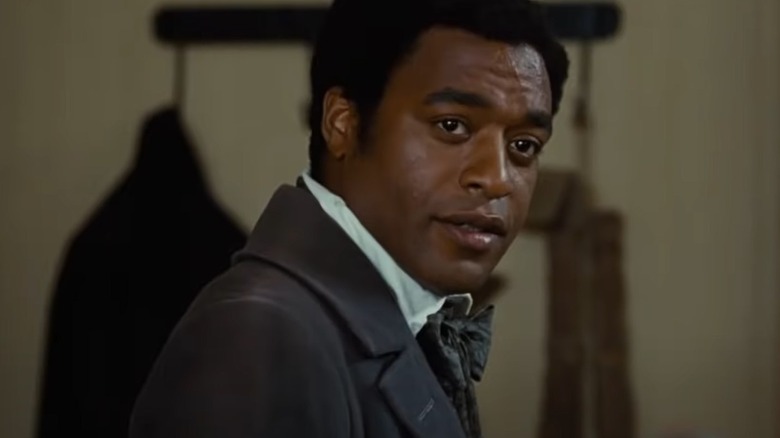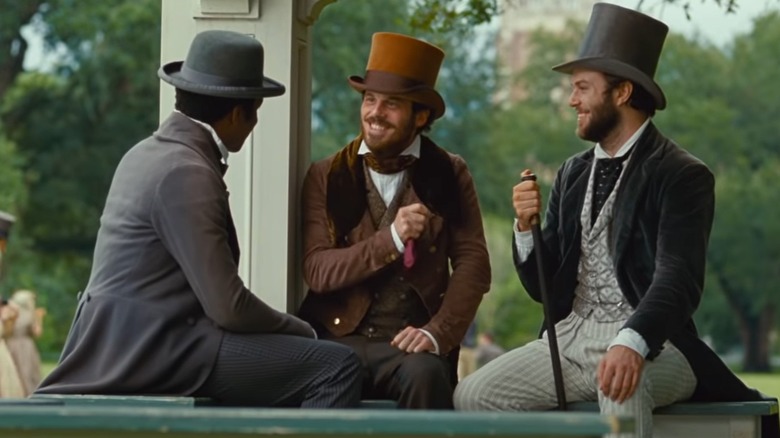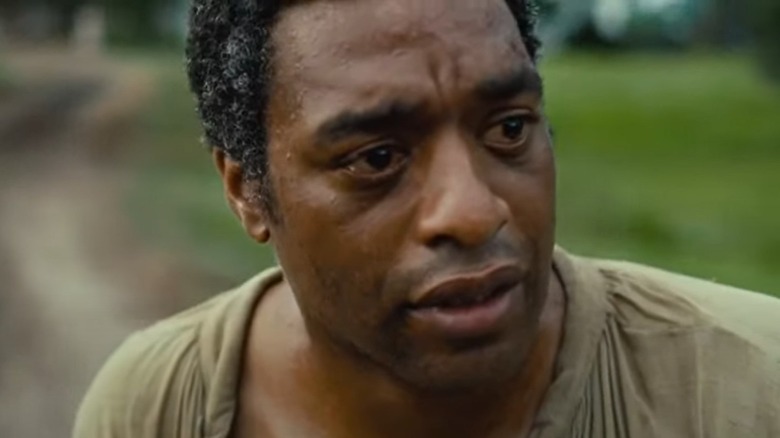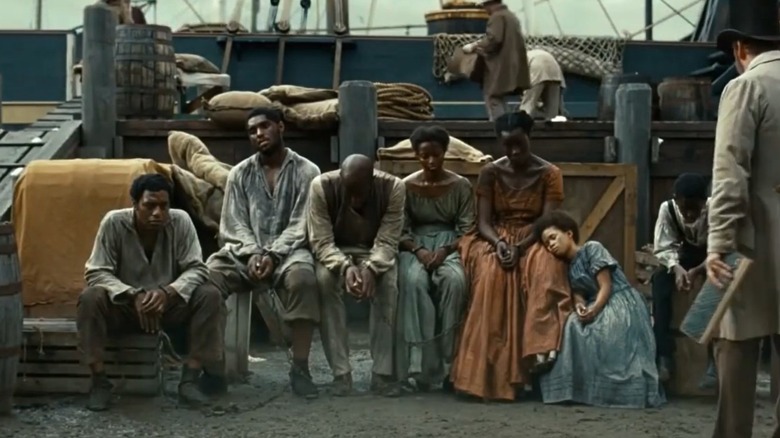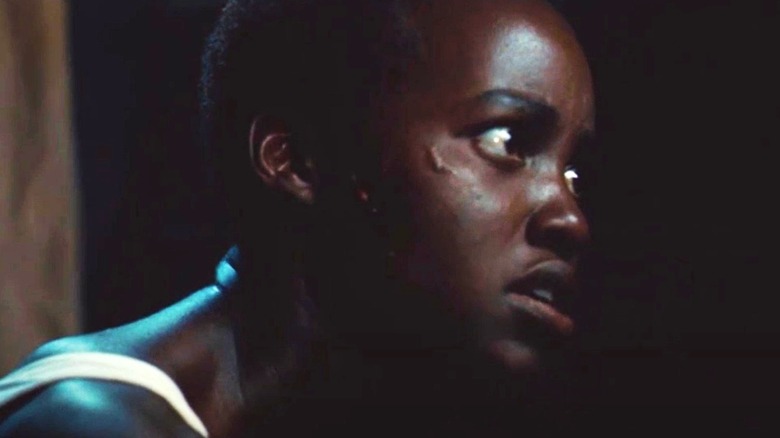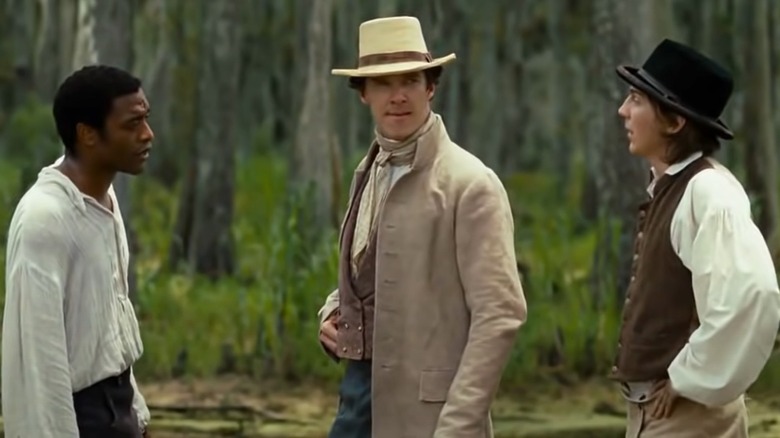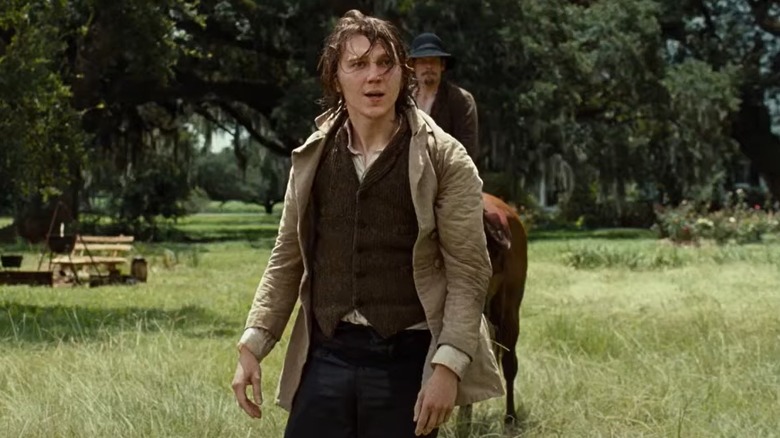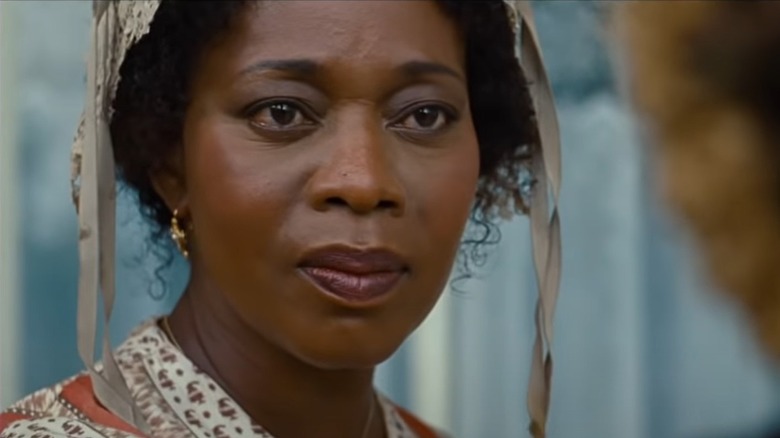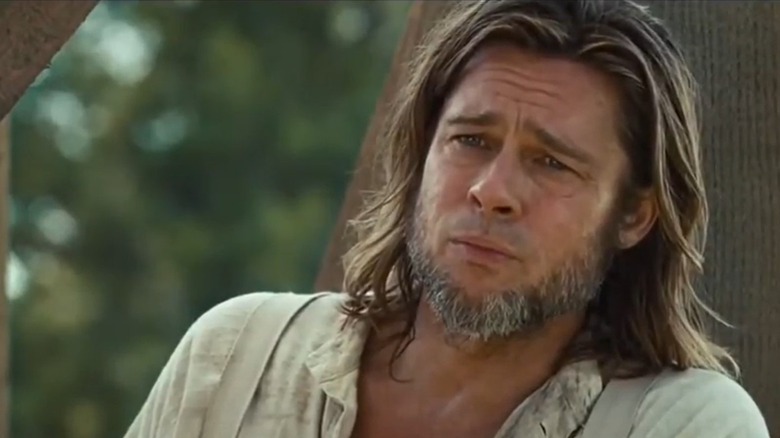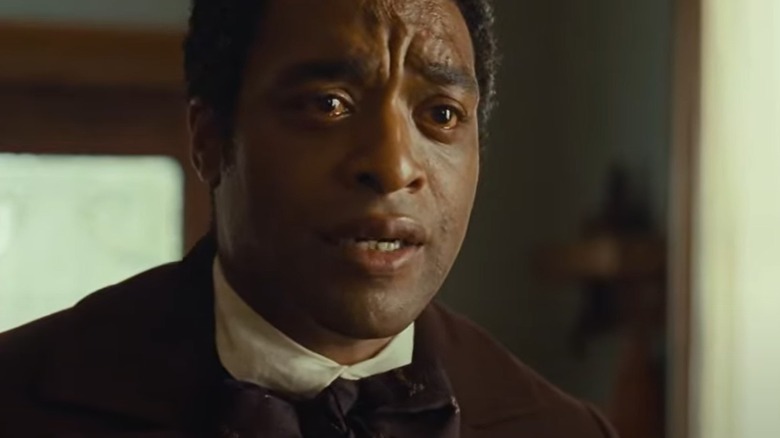Everything 12 Years A Slave Doesn't Tell You About The True Story
Based on the memoir about Solomon Northup, "12 Years a Slave" follows Northup as he is kidnapped and sold into slavery, despite being a free man in America. For 12 years, Northup suffered at the hands of several slave owners as he tried to escape and regain his freedom. He endured dehumanizing hardships but never lost his resolve or desire to see his family again. The violence and cruelty on display in "12 Years a Slave" is not very easy to watch, but all of it is necessary in order to portray an authentic look at slavery in the 1800s. The portrayal is so authentic that the film won three Academy Awards, including best motion picture and best supporting actress for Lupita Nyong'o's portrayal of Patsey, a fellow slave whose tragic story is interwoven with Northup's.
A lot of what happens in the film "12 Years a Slave" is taken directly from the pages of the book with the same name. But even so, the film isn't entirely historically accurate. A handful of moments from Northup's account are either cut or altered in adaptation. Plus, since the film is told entirely from Northup's perspective, there are certain facts about the supporting characters that are left out. Some aspects of Northup's life aren't elaborated upon, either. Here is a rundown of what the "12 Years a Slave" film adaptation doesn't tell you about the whole story.
Solomon Northup's life before his kidnapping and his father's early life as a slave
The movie doesn't spend very much time on Solomon Northup's life before he is kidnapped. There are a handful of brief scenes with his family and of Northup performing as a violinist, but the next time we see him with his family isn't until the end of the movie, after he is rescued 12 years later. According to the African American Registry, Northup was born in the early 1800s to a mother who was a free woman and a father, Mintus, who was originally a slave before being freed in the will of his previous master, Henry Northup. Mintus assumed his former master's surname once he was freed. Along with his older brother Joseph, Solomon spent his early years working on his father's land, which his father had acquired in order to obtain the right to vote.
Solomon Northup was married in 1828, a year after the death of his father. He followed in his father's footsteps, started a family of his own, and became a farmer before selling his property to become a musician, according to Britannica. Northup's profession as a violinist comes up several times in the film, with one of his masters even gifting him the instrument as an act of gratitude.
The real names of Solomon Northup's kidnappers, and whether or not they were brought to justice
Solomon Northup's life takes a turn when he runs into two men who go by the names of Merrill Brown and Abram Hamilton. The two men have drinks with Northup and entice him with a job opportunity to perform music out of state. But these two men were actually there to drug Northup and kidnap him so he could be sold to his first slavemaster. These two men are not seen again in the film after this, but they did reappear in Northup's life after he was freed.
After Northup gets his freedom back, there were several different legal proceedings that he went through against those who wronged him. One of those proceedings was against his own kidnappers. According to Smithsonian Magazine, Northup wasn't aware of the full identities of his kidnappers, but a New York City judge was able to identify the two men as Alexander Merrill and Joseph Russell. A case was brought up against Merrill and Russell in 1854, but the charges were dropped for unknown reasons a few years later. Sadly, this isn't the only time that Northup's torturers didn't face justice, as the legal system back then was especially favorable to slave owners and their accomplices.
The media covered Solomon Northup's court cases before he wrote his book
After Solomon Northup is rescued and sent away from Edwin Epps' plantation, he is reunited with his adult children and tearfully apologizes for his absence. The film then cuts to black and uses title cards to explain that Northup was unsuccessful in his lawsuits against his previous owners and the circumstances surrounding his death remain unknown. This is the only time the film talks about Northup's post-slavery life, most likely to not take away from the horrors of slavery that is supposed to be the main focus.
Smithsonian Magazine details the other court cases Northup tried. Northup's rescue gained a lot of attention when his story was covered in The New York Times. His case against James Burch, the first man to have Northup in his custody, also received media attention. Similar to Merrill and Russell, the charges against Burch didn't lead to a conviction. This is partly because, at the time, Washington law prohibited Black witnesses from testifying against white defendants, which meant that Burch could testify that he really thought Northup was a true slave without anyone questioning it.
The court cases against Northup's two kidnappers soon followed. According to Northup's Britannica biography, Northup's story gained even more attention and his cases went to both the New York State Supreme Court and the state's Court of Appeals. But, as previously stated, nothing came of these cases.
The mutiny on the slave ship was called off for a very different reason
After being drugged and captured, Solomon Northup is brought onto a slave ship with several other people. Though Northup is instructed to stay quiet as much as possible, another slave that goes by the name of Robert wants to rebel against the slavemasters. Though Northup did briefly consider performing an act of defiance, the plans were scrapped when Robert was murdered after one of the masters attempted to rape a female slave in the middle of the night.
It's a tragic scene that highlights how brutal being a slave was, but it didn't actually happen. An article from The Atlantic details how the film played fast and loose with facts in order to achieve a more dramatic effect. The article states that while there was a slave that died on the ship, it was actually from smallpox, not a stabbing. Dying from a disease is not as tragically exhilarating as suffering at the hands of a slavemaster, so this change feels like it was made solely for shock value.
This isn't the only instance of the movie being more dramatic than the text. The article also details how the sexual encounter between Northup and another woman shown in a flashback at the beginning of the film didn't happen either. Rather, director Steve McQueen added it to show "a bit of tenderness." Once again, another instance of shock value to highlight cruelty.
Patsey and Solomon Northup's heartbreaking conversation was misinterpreted
Patsey's character throughout "12 Years a Slave" is defined by the pain she endures at the hands of Epps. She is not only the object of his ire, but she is also regularly raped by the sadistic man. Patsey also suffers at the hands of Epps' wife, Mary, who beats her regularly in front of the other slaves. It becomes so much for Patsey that there is a scene in the movie where she approaches Solomon Northup in the middle of the night and asks him to end her life. Despite her desperate pleas to Northup, he refuses to end her life, especially in the violent ways she describes.
But while the scene itself is tragic to see, it didn't actually happen that way. The Atlantic explains that Northup never wrote about Patsey wanting to end her own life. Though he does describe her desire to escape from Epps' plantation, he never says she wanted him to kill her. The violent scenario Patsey described to Northup — a drowning — was allegedly suggested by Mary Epps as another way for her to torture Patsey. Mary Epps is already a cold character, but this would have made her just as bad as her husband.
Solomon Northup's description of Ford is more positive on the page than on the screen
Solomon Northup's enslavement brought him onto the plantation of William Ford, a Christian man who is at war with himself over keeping his faith while also recognizing the evils that he sees with slavery. None of the slave owners are given a very glowing portrayal in "12 Years a Slave," and Ford is no exception. While Ford does show remorse for how Northup and the rest of the slaves are treated, he is still portrayed as a hypocrite, rather than as a righteous person.
This portrayal caused some conflict with Ford's descendants when the film came out. In an interview with the Daily Mail, Ford's great-great-grandson William Marcus Ford argued that the film's portrayal of Ford was "too dark" and didn't match what Northup wrote. "It wasn't illegal. That doesn't make it right or moral by today's standards but back then it wasn't an ethical issue," Ford said. "Northup saw him as a kindly person. He was a highly moral man."
There were passages in the book where Northup described Ford as a kind man and admired his faith in God. The film does go out of its way to show Ford being kind to Northup and shows him sending Northup away when he believes things will get too violent. But the kindness is quickly overshadowed by every other terrible thing that happens to Northup, especially from Ford's own people.
Another fight with Tibeats didn't make it into the film
While being enslaved on the Ford plantation, Solomon Northup clashes with the sadistic carpenter, John Tibeats. One of their worst encounters happens when Northup and Tibeats argue over some nails. The argument devolves into a chase where Northup beats up Tibeats, but it ends with Tibeats' men stringing up Northup and hanging him by his toes. This is one of the instances that leads to Ford sending Northup away to be with Edwin Epps, the most notorious slave owner in the whole movie.
Tibeats may only be on the screen for a small portion of the film, but his impact on the narrative is felt immediately. It would have been even more impactful if the second fight that Northup wrote about made it into the film. As pointed out in a review by Facing South, Northup got into a second altercation where he would again beat up Tibeats, leading to a chase in a swamp.
This is just one of several instances in the article where the film doesn't highlight any meaningful type of rebellion from the slaves, which Northup describes in several instances in the book. The Facing South article states that the lack of fighting back does a disservice to history, as Northup's way of fighting back wasn't unique to him.
The conversation with Patsey and Shaw didn't really happen the way it did in the movie
Solomon Northup's time with Edwin Epps is marked by much cruelty and heartbreak, more than any other time in the film. At one point, there is a scene where Northup runs into fellow slave Patsey, who is in the middle of a conversation with Mistress Harriet Shaw, the Black wife of a white plantation owner. Northup initially comes to fetch Patsey for Epps, but Shaw insists that he sit down and have tea with her. During this conversation, Shaw explains how she managed to escape being a slave by marrying her former master.
It's a discussion that ultimately serves to offer hope to Patsey, who is suffering the most under Epps. However, it's also a conversation that didn't actually happen in the book. Screenwriter John Ridley, who won the Academy Award for best adapted screenplay for this film, told Vulture that it was difficult to create a scene that Northup only described with two lines in his memoir.
"I thought that was really important to include," Ridley said, "because a lot of folks may have been completely unfamiliar with the concept of the woman of color in that era being able to elevate herself to a degree, or the notion that a white master may have felt secure enough not just to have a Black mistress, but one that he could have a relationship with openly on that level."
Samuel Bass' role in Solomon Northup's freedom is crucial, but leaves another important person
Solomon Northup's torture finally came to an end thanks to the help of Samuel Bass. Bass was hired by Edwin Epps to help him and Northup on a construction project. Much to Epps' chagrin, Bass vocalizes his dislike of slavery. This prompts Northup to reveal who he really is to Bass and ask him to help send letters to people he knew prior to enslavement in order to secure his freedom. After a long wait, Northup is rescued and taken back to his family.
Like many other characters, Bass' life isn't focused on as much as Northup's. Prior to arriving on Epps' plantation, Bass was born in Canada but came to the United States to find work. It was here that he ran into Northup. But according to an article from The Globe and Mail about Bass' positive portrayal, an important aspect of Northup's rescue is altered in adaptation. A historian says a lawyer by the name of Henry B. Northup was crucial in getting the necessary resources together in order to ensure Solomon's rescue. None of these legal proceedings are shown in the film, but an interesting fact about Solomon's rescue is that Henry Northup was related to Solomon's father's former master, with whom they shared the same name.
All the theories surrounding Solomon Northup's death
One of the most tragic elements of the slave trade is how the identities of so many people were erased from history. Solomon Northup's name is changed to Platt by a slave trader, and he is called that for the remainder of his enslavement. Patsey also goes by a singular name throughout the movie, most likely given to her as well. After Northup is rescued, he does not see Patsey again. According to the Journal of the Civil War Era, Patsey was able to escape Epps' plantation after the original "12 Years a Slave" book was published and her story caught the attention of Union soldiers, but what happened to Patsey after her rescue remains a mystery.
Unfortunately, there is also no record of when or how Northup died. There have been rumors about what happened to Northup for years, but it has been hard to prove them. Some of these theories, compiled by BlackHistory.com, include Northup getting captured and killed while serving as a spy for the Union Army, being thrown back into slavery for the second time, or simply not wanting to be found and dying in a place where no one could find him. The end of Northup's life may still be a mystery, but at least he was able to give a voice to his and Patsey's stories to ensure that they wouldn't be forgotten.

